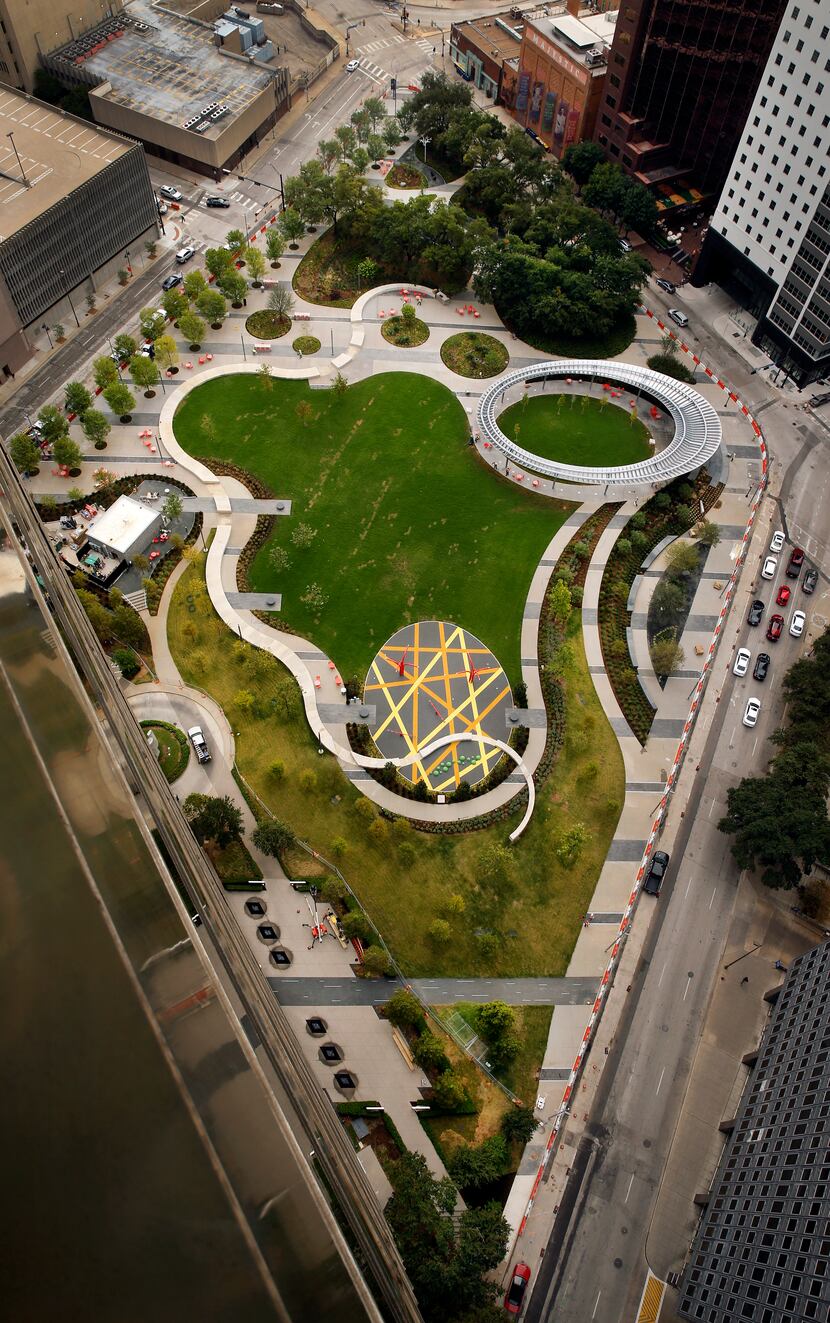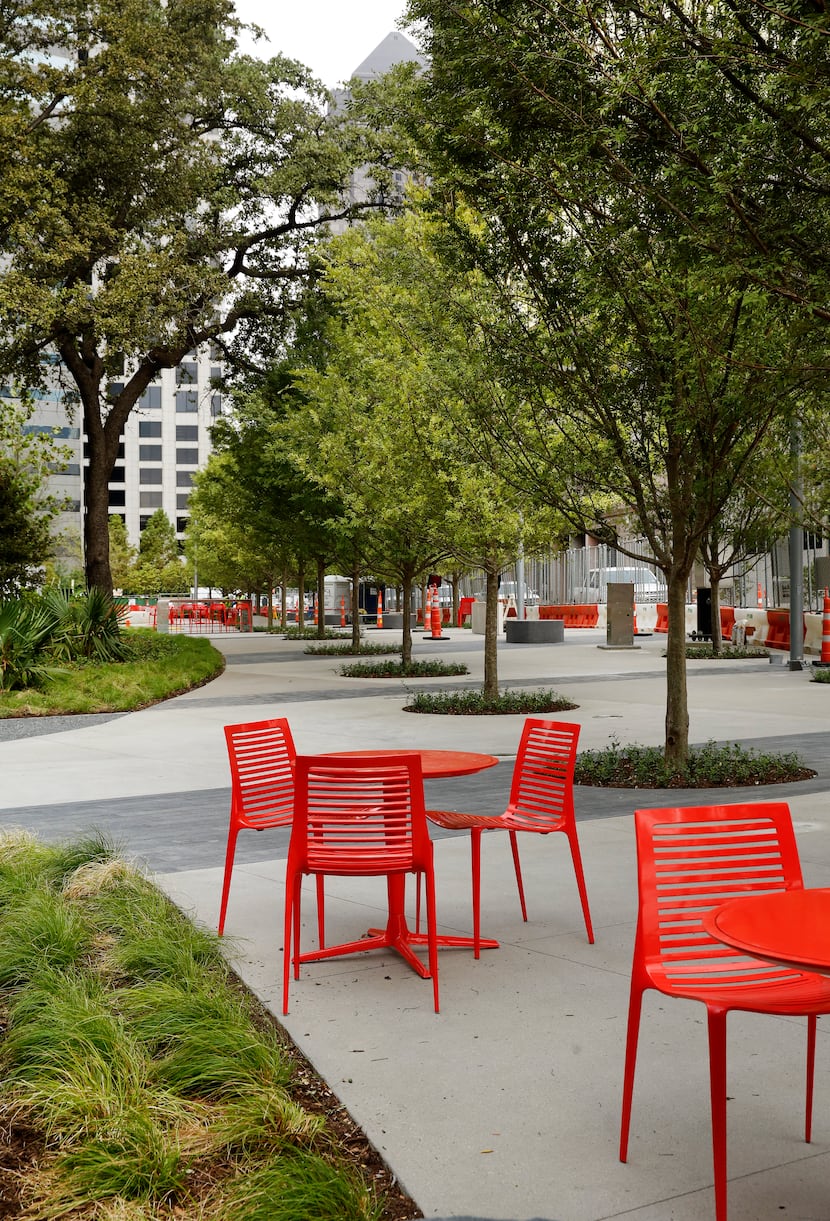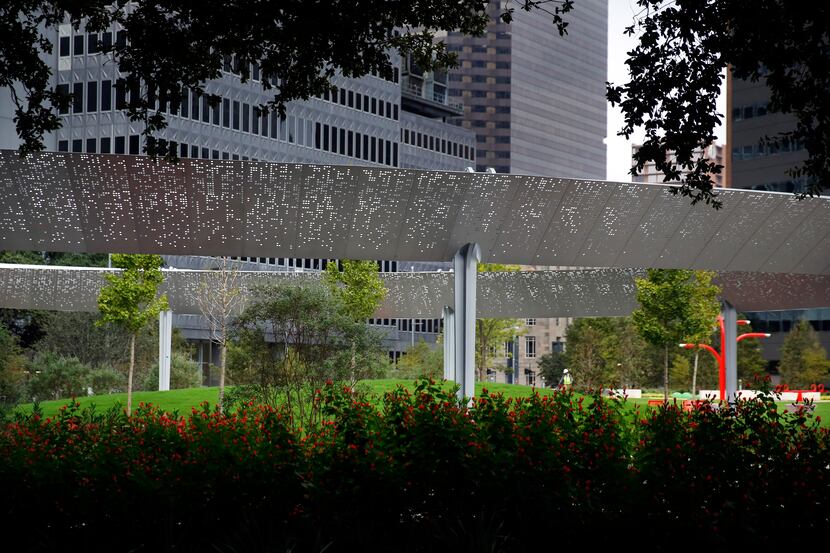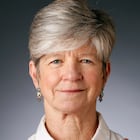A 3.7-acre swath of downtown Dallas — formerly a parking lot for as long as anyone can remember — opens to the public Monday as the city’s newest urban neighborhood park.
Funded by Parks for Downtown Dallas, Pacific Plaza is the first of four new green spaces the nonprofit expects to help open in the city’s core by the end of 2022. More than a decade of work has gone into the east-side park’s development.
The transformation of the no-man’s land around Pacific Avenue and Harwood Street is significant for many reasons: It illustrates the successful public-private partnerships vital to the city’s future. It contributes to the tax base to fund needs citywide. It provides environmental relief to the concrete furnace of urban density.
Most important, trees make folks happy and healthy. Scientific studies into the correlation between urban green space and mental and physical well-being say just that.
Under a cloudy, rain-spitting sky Thursday, construction fencing came down and swings went up as workers put the final touches on Pacific Plaza. The green space is a pastoral refuge framed by towering buildings that tell downtown’s architectural history, with a topography elevated from the street
Amy Meadows, president of Parks for Downtown Dallas, said in an interview Thursday, “Green space is changing the way people view downtown. It’s no longer this concrete jungle focused solely on business. It’s about quality of life and what brings people together — and I would add dogs, too. Don’t forget the dogs.”
Pacific Plaza hasn’t.
Among its innovations are “dog intercepts,” crushed-granite spaces with large dark rocks near the park’s perimeter where Fido is invited to take care of business. Twice daily, an irrigation system washes the uric acid into an extensive network of sub-drains connected to the sewer system.
“If we can train dog owners to use these areas, we have the potential to reduce the buildup of offensive smells and reduce lawn problems,” Chuck McDaniel, landscape architect and managing principal in SWA Group, which designed the park, said during a walk-through Thursday.

A parking lot transformed
The new Pacific Plaza pays subtle homage to the railroad and trolley traffic that ran through the property for generations. Even before families pulled up in Model Ts, travelers parked their horse-pulled buggies on this site.
Anchoring the park’s southwest corner is an elliptical stainless steel pavilion designed by HKS Architects. The structure is punched with holes representing the Morse code names of every local stop — 337 of them — along the Texas and Pacific Railroad between El Paso and New Orleans.
Across the park, the 300-foot Harwood Promenade is lined on both sides with lacebark elms, some of the 144 new trees planted in Pacific Plaza. This eastern-edge walkway leads visitors into Aston Grove, a rare urban forest of 23 majestic live oaks. Planted there in 1983 as part of the tiny Aston Park — long unused and untended — these trees now stand as the granddaddies of Pacific Plaza’s contemporary feel.
Flambé orange playground equipment and seating border the 1-acre central lawn. “The Thread,” a limestone seat wall that winds through the space, stitches it all together. Parking is prohibited alongside the park — “we don’t want a wall of cars,” McDaniel said — but space is provided for six food trucks.
Residents have waited a long time for Pacific Plaza, said Meadows with Parks for Downtown Dallas. “In 2008, a sign went up on this parking lot that said ‘park coming soon.’ Here we are, finally in October 2019, opening a park,” she said.
It took a decade of planning and investment by the city’s Park and Recreation Department, The Trust for Public Land and Parks for Downtown Dallas to create Pacific Plaza, which will officially open with a dedication ceremony at 4:30 p.m. Monday.
The Pacific Plaza ceremony is the last official hurrah for retiring Dallas Park and Recreation director Willis Winters. During a recent late-night walk-through to check the park’s lighting, he admitted to taking a turn on one of the teeter-totters with McDaniel.
“Somebody’s got to test the equipment before we allow the public in,” Winters laughingly said.
In his 27-year park department career, Winters has toured the best projects in the country and helped create among the most noteworthy in Dallas. His assessment in an interview Friday: “Pacific Plaza will rank as one of the great urban parks in America.”
“It has hit the right balance of programming and innovation — beauty, history, landscape architecture and the pavilion’s design,” Winters said.
Parks for Downtown Dallas funded the entire $15 million required to create the park as well as putting a $1 million endowment in place for enhanced maintenance.

Parks on the drawing board
Robert W. Decherd is chairman of Parks for Downtown Dallas and has been involved with planning and design issues in the core of the city for 40 years. In 2018, Decherd resumed his former role as chief executive officer at A.H. Belo, which owns The Dallas Morning News.
Parks for Downtown Dallas is hard at work on three more oases, each of which will be paid for with private donations and public dollars approved in the city’s 2017 bond vote.
Dallas’ urban core already hosts the showpiece Klyde Warren Park and two green spaces on downtown’s historic spine —Main Street Garden and Belo Garden. Add to that the acreage committed to Pacific Plaza and Parks for Downtown Dallas’ remaining three priorities, and the city center’s green space will have grown by 23 acres, or about 17 football fields, from 2009 to 2022.
“Seven different parks all over the center of the city — that’s hard to match anywhere in the country,” Decherd said Thursday.
With offices that face Pacific Plaza, The Trust for Public Land and its North Texas director, Robert Kent, had a front-row seat to what he describes as “a magical transformation” from an ugly asphalt parking lot to park.
Kent’s office estimates that 6,200 people live within a 10-minute walk of Pacific Plaza. “Those 6,200 people now have a beautiful green space to play, to walk their dogs, to picnic with their family or to just seek solace,” he said.
Kent also touted the environmental benefits that Pacific Plaza will bring. For instance, replacing a parking lot with grass and trees reduces urban heat islands — sunlight baking onto concrete and then radiating heat back out into the surrounding environment.
The Trust for Public Land has been involved in Pacific Plaza since Dallas passed its first downtown parks master plan in 2004.
City Hall wanted a park at Pacific and Harwood, but at the time did not have the money to tie down the property. The Trust for Public Land spent about $6 million to purchase the majority of the site that now makes up the park. With money from the 2006 bond program, the city bought that land from Kent’s group.
“It was the right move for us because at the time there were a lot of people circling and trying to figure out what to do with that parking lot,” Kent said Thursday.

The second green space wave
Pacific Plaza heralds a second wave of parks downtown, following the opening in 2009 of Main Street Garden, funded by the city, and the 2012 dedications of Belo Garden and Klyde Warren Park, both public-private partnerships.
Parks for Downtown Dallas, formed in 2015 out of the nonprofit formerly known as The Belo Foundation, is dedicated to implementing the parks master plan. The nonprofit’s goal: four urban neighborhood green spaces funded by $39 million already approved in city of Dallas bonds and more than $49 million in committed private money.
Next on the foundation’s list is West End Square. Transformation of the surface parking lot adjacent to the old Spaghetti Warehouse building will begin in January, and Meadows hopes the ¾-acre park will open by early 2021.
The West End is increasingly attracting technology, innovation and startup companies. In response, the new park will feature a giant custom-made worktable and charging stations throughout the space.
“What we hope is that the individuals working in the surrounding buildings — a very tech-focused, creative class — will work right there in the park,” Meadows said.
On the eastern edge of downtown, Carpenter Park will spread across 5.6 acres. Construction is set to start next spring and, when finished two years later, this green space will be the largest park in the city’s core.
Finally, Harwood Park, not far from the Dallas Farmers Market, will break ground in spring 2021 and require about 18 months to build. This park will cover almost 4 acres and include two historic buildings on its edge.
Meadows said her group doesn’t envision Pacific Plaza and the green spaces still to come as Klyde Warren-like destination parks. “These are designed as neighborhood parks because people are actually moving back into the downtown core,” she said. “This is about work, live and play all together in one place.”

The greater good
The parks also attest to the adage that capital follows capital — and capital protects capital. As the private sector began putting more money into downtown, others saw the success generated by the first chapter of the city core’s restoration.
Additionally, the money already being invested in buildings around Pacific Plaza — a smaller version of the explosive growth around Klyde Warren — increases tax dollars for the general revenue fund. “As the city becomes more mature and its balance sheet is increasingly stretched, it will need private-public partnerships to meet a variety of needs — not just parks,” Decherd said.
Once roadblocks beyond its control were cleared, Parks for Downtown Dallas pulled off the transformation of Pacific Plaza under budget and ahead of schedule.
The result is a park that allows for reflection or frolicking, a green space that cleans up the air and eases pressure on city finances.
“These parks are for everyone,” Meadows said. “You feel good when you are in them. These parks make our downtown human.”

